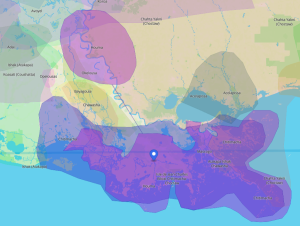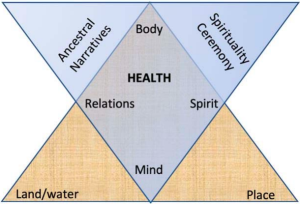Returning to our Roots: Tribal Health and Wellness Through Land-Based Healing
Citation
Johnson-Jennings, M., Billiot, S., & Walters, K. (2020). Returning to our roots: Tribal health and wellness through land-based healing. Genealogy, 4(3), 91. doi.org/10.3390/genealogy4030091
Settler colonization in the US violently removed Indigenous people from their ancestral lands. Health inequity is one of many lasting impacts of this colonization. Indigenous people have higher rates of obesity, heart disease, and diabetes than other groups in the US.1 Reconnecting with land can help improve health outcomes. For example, original land (i.e., traditional Tribal lands) can provide access to ancestral food, traditional medicine, and cultural practices.2, 3 Indigenous beliefs often view land as a living being or mother. Land-based healing provides a way for Indigenous communities to reconnect to the land and reestablish traditional wellness practices.

A 2020 study led by Michelle Johnson-Jennings, PhD, focused on the United Houma Nation in Louisiana. Researchers studied how reconnecting with the land supports Indigenous health and well-being. The study first identified social beliefs that affect health. To choose these beliefs, researchers conducted a week-long, 126-mile journey with 20 Houma women. They called the journey Returning To Our Roots. Participants spent time on Houma land, canoeing through sacred waters, and visiting cultural places. They completed reflections and interviews. They explored how spending time with the land and water helped process trauma.
From this journey, five cultural health beliefs were chosen:
- Place and creating space: centering land and place to strengthen connection to it
- Ancestors: ancestor resilience and how to support future generations
- Spirituality and mindfulness: land and water increased feelings of spirituality and mindfulness
- Cultural continuity: desire for culture to live across generations
- Environment and health: human health is tied the environment

Next, there needed to be a way to help implement these beliefs. Participants, researchers, and Tribal leaders collaborated to create the Uma Hochokma Framework (right).
Findings from Returning to Our Roots and the framework imply that land is central to Houma’s health. Spending time on sacred land rejects colonial trauma narratives. Instead, it encourages resilience, hope, and healthy behaviors.
Abstract
Background
Settler colonialism has severely disrupted Indigenous ancestral ways of healing and being, contributing to an onslaught of health disparities. In particular, the United Houma Nation (UHN) has faced large land loss and trauma, dispossession, and marginalization. Given the paucity of research addressing health for Indigenous individuals living in Louisiana, this study sought to co-identify a United Houma Nation health framework, by co-developing a community land-based healing approach in order to inform future community-based health prevention programs.
Methods
This pilot tested, co-designed and implemented a land-based healing pilot study among Houma women utilizing a health promotion leadership approach and utilized semi-structured interviews among 20 UHN women to identify a UHN health framework to guide future results.
Results
The findings indicated that RTOR was a feasible pilot project. The initial themes were
- Place
- Environmental/land trauma
- Ancestors
- Spirituality/mindfulness
- Cultural continuity
- Environment and health
The reconnection to land was deemed feasible and seen as central to renewing relationships with ancestors (aihalia asanochi taha), others, and body. This mindful, re-engagement with the land contributed to subthemes of developing stronger tribal identities, recreating ceremonies, and increased cultural continuity, and transforming narratives of trauma into hope and resilience. Based on these findings a Houma Health (Uma Hochokma) Framework was developed and presented.
Conclusions
Overall, this study found that land can serve as a feasible therapeutic site for healing through reconnecting Houma tribal citizens to both ancestral knowledges and stories of resilience, as well as viewing self as part of a larger collective. These findings also imply that revisiting historically traumatic places encouraged renewed commitment to cultural continuity and health behaviors—particularly when these places are approached relationally, with ceremony, and traumatic events tied to these places, including climate change and environmental/land trauma, are acknowledged along with the love the ancestors held for future generations.